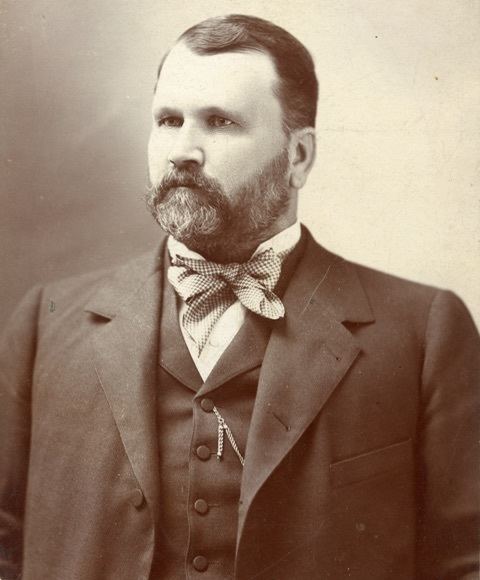Name Wilfred Cutshaw | ||
 | ||
Wilfred Emory Cutshaw (January 25, 1838 - December 19, 1907) was a colonel in the Confederate Army and prolific city engineer for Richmond, Virginia for 34 years.
Contents
Early life
Wilfred Emory Cutshaw was born in Harpers Ferry, Virginia, present day West Virginia, to George W. Cutshaw and Martha J. Moxley. Following education gained at home and a local academy, he graduated Virginia Military Institute in 1858 after studying civil and military engineering. After teaching briefly in Loudon County, he served as an instructor at the Hampton Military Institute. In the spring of 1861, Cutshaw resigned from his teaching post to enlist in the Confederate Army.
Civil War
Cutshaw rose quickly through the ranks in the Confederate Army. In 1861, he was made a first lieutenant, serving in the battalion of artillery in General Thomas Jonathan Stonewall Jackson’s brigade. One year later he was made captain of artillery and in the fall of 1862, a major. Finally in February 1865 he was appointed lieutenant colonel.
His battle interactions included combat under General John B. Magruder on the Peninsula during the summer of 1861, and Jackson in the Valley in 1862. During that same year in the First Battle of Winchester, he was shot in the knee and captured by Federal forces. A prisoner exchange occurred in April 1863, and upon returning to the Confederate Army Cutshaw was deemed medically unfit to serve. He returned briefly to a teaching position at Virginia Military Institute before re-enlisting in the army, unhealed, in 1863. He served for three more years when, in 1865 at the Battle of Sailor's Creek, three days before the General Robert E. Lee's surrender at Appomattox, he was shot in the right leg. The wound was severe and his leg was amputated.
City Engineer, Richmond Virginia
Between 1865 and 1873, Cutshaw held several occupations, including professor at Virginia Military Institute and assistant to Charles P. Stone, engineer and superintendent of the Dover Coal and Iron Company.
Upon the death of Richmond's standing city engineer in 1873, Charles H. Dimmock, Cutshaw was elected as the new official for the post. Cutshaw inherited a city suffering from the damage of a lost war and devoted his efforts towards renewal of public infrastructure. He undertook numerous projects during his tenure, and was heralded as a proponent of spaces for public recreation. In 1879 Cutshaw embarked on a tour of northern United States and European parks and incorporated what he saw into plans and designs for public spaces in Richmond. In this manner he contributed in bringing the City Beautiful movement to Richmond along with its ideals of urban beautification and civic grandeur. Among Cutshaw's important efforts are Monroe Park, the Boulevard, an urban nursery that provided for over 50,000 trees for the city, a public reservoir in Byrd Park, and conversion of hills into developable spaces and parks, including Libby, Gamble's, and Chimborazo Hills. A sign memorializing Cutshaw was erected in 2015 by the Virginia Department of Historic Resources at Byrd Park in front of the round house, 621 Westover Road.
Cutshaw oversaw projects of multiple scales; not only was he responsible for the creation of the city's grid and waterworks system, but significant architectural achievements as well. Among these was the Old City Hall in 1886, an example of high gothic architecture built from locally quarried granite and constructed by day laborers overseen by Cutshaw. Additionally, the Byrd Park Pump House of 1883 is an example of Cutshaw's hallmark combination of utility and social life in his projects. Built to pump water from the James River and Kanawha Canal into the Byrd Park Reservoir, Cutshaw integrated an open-air dance floor on the second floor of this stone gothic building, to which the city's elite would arrive via boat for social events. Numerous public works including fire stations, markets, schools, and armories were also erected during Cutshaw's tenure, exhibiting a range of architectural styles. The architectural assistant in Cutshaw's office responsible for some of the design and documentation of these buildings, including the 1895 Howitzer's Battalion, was a young Henry E. Baskervill, founder and ancestor of one of Richmond's most prolific contemporary firms, Baskervill.
Personal life and legacy
Cutshaw held membership in the Royal Arcanum, Southern Historical Society, Virginia Historical Society, Richmond Young Men's Christian Association and served as the president of Virginia Military Institute Alumni. He was married twice, first in 1876 to E.S. Norfleet, and in 1890 to M.W. Morton. Both women died within a year of marriage. He had no children. He was elected a member of the American Society of Civil Engineers in 1891, and after his death, remembered in a plaque inside the Old City Hall.
